Complete Solutions to Level-6 of chapter ALKYNES of Class 11 book with complete answers and questions
| Class 11 | CHEMISTRY |
| Chapter | ALKYNES |
| NARAYANA | Level-6 |
| Number Of Questions | 100 |
| Academic Year | 2023-24 |
Complete the following reaction

View Solution
The Reactant A is
View Solution
Which reagent will be used for the above conversion?
View Solution`H_(2)C=CH-C=CH+HCIrarrX,X'is:`
View SolutionWhich would produce chiral molecule after treatment with Lindlar catalst?
View SolutionHow is the following transformation best carried out?
 .
.
View Solution`3CH_(3)-C=Choverset(Red hot)underset(Cu tube)rarr`
View Solution`CH_(3)CH_(2)C=Choverset(NaNH_(2)//NH_(3)(l))rarr overset(CH_(3)CH_(2)Br)rarr overset(Li,NH_(3)(l)rarr`
View Solution`CH_(3)CH_(2)CH_(2)-overset(O)overset(||)(C)-H+CH_(3)-C-=CH overset(Na,NH_(3)(l))to`
View SolutionThe Products of the following I and II sequences are related as:
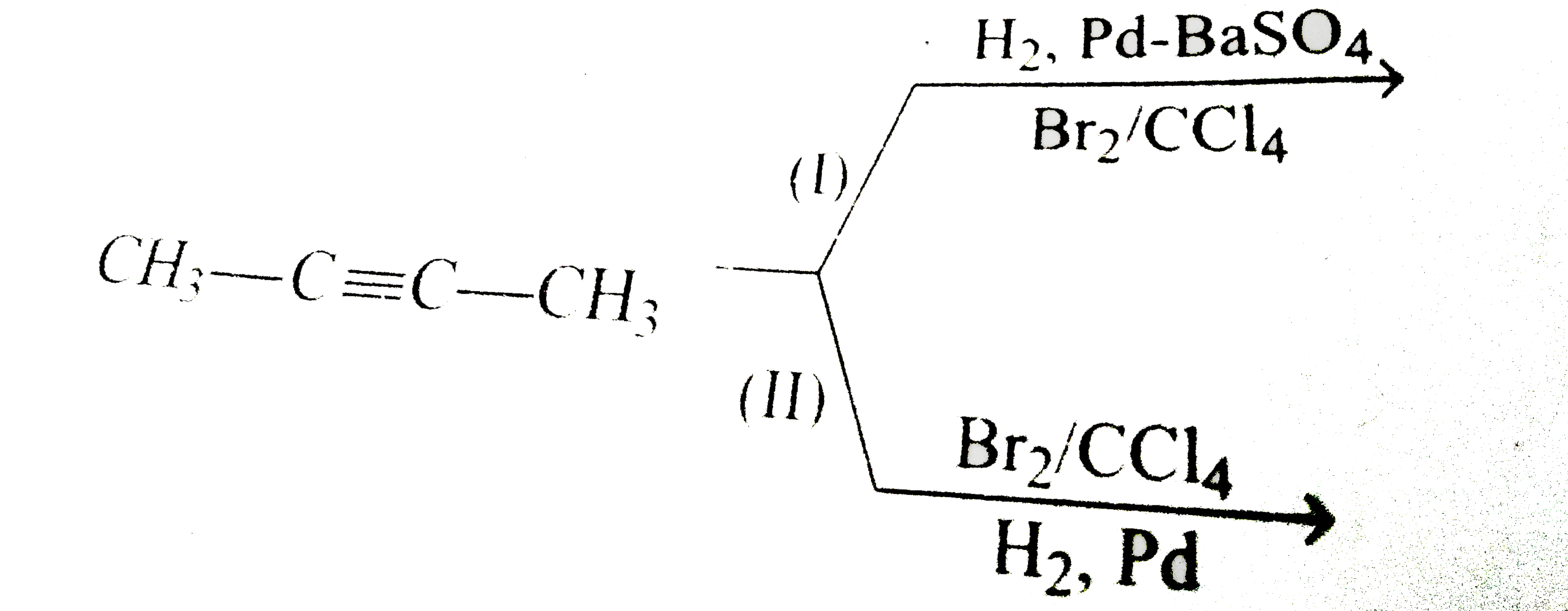
View SolutionComplete the following reaction
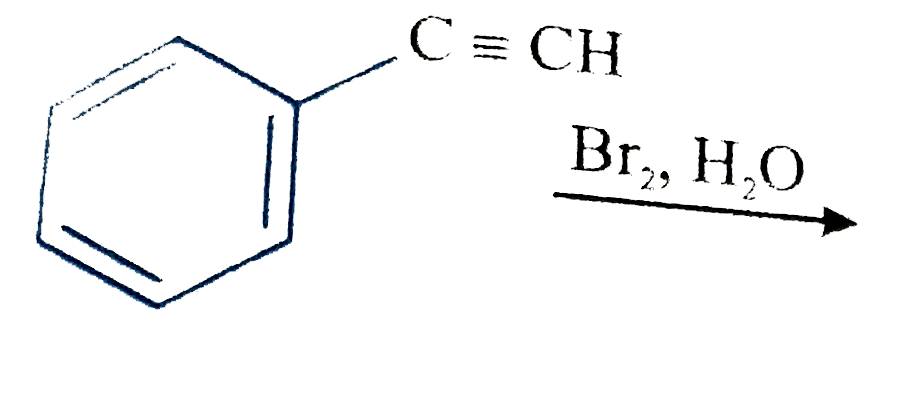
View Solution`HC=Choverset(KNH_(2))underst(CI-(CH_(2))_(8)-CI)rarrAoverst(H_(2))underst(Pd-CaCO_(3))rarrBoverset(Br_(2)//CCI_(4))rarrCoverset(KNH_(2))underset(2 Mole)D`overset(Na,NH_(3)(l))rarrE,E is:
View SolutionWhich is the most suitable reagent among the following distinguish comound (3) from the others?
(1) `CH_(3)C-=C-CH_(3)` (2) `CH_(3)CH_(2)-CH_(2)-CH_(3)`
(3) `CH_(3)CH_(2)C-=CH` (4) `CH_(3)CH=CH_(2)`
View SolutionTwo gases P and Q both decolourise aquieous bromine buyt only one of them gives white ppt. with Tollen's reagent.P and Q likely to be:
View SolutionWhich of the following hydrocarbons should be choosen as a starting material to prepare 3- hexanone by the hydration?
View Solution
End product B is :
View Solution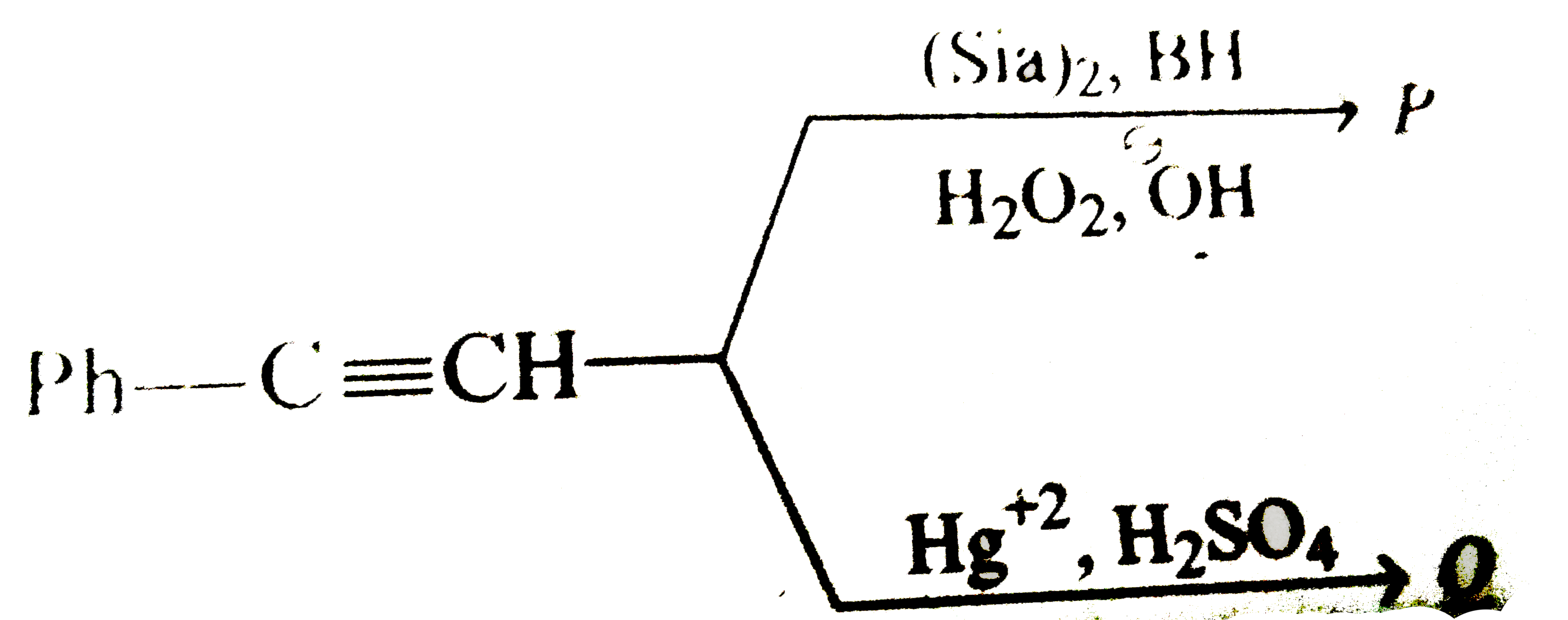
P and Q are respectively:
View Solution`CH_(3)C=CH_(3)overset(BH_(3).THF)underset(CH_(3)COOH)rarrMajor porduct:
View SolutionWhich alkyne will give 3-ethylhexane on catalytic hydrogenation?
View SolutionWhich reaction yields the major product shown?
View Solution Major product:
Major product:
View Solution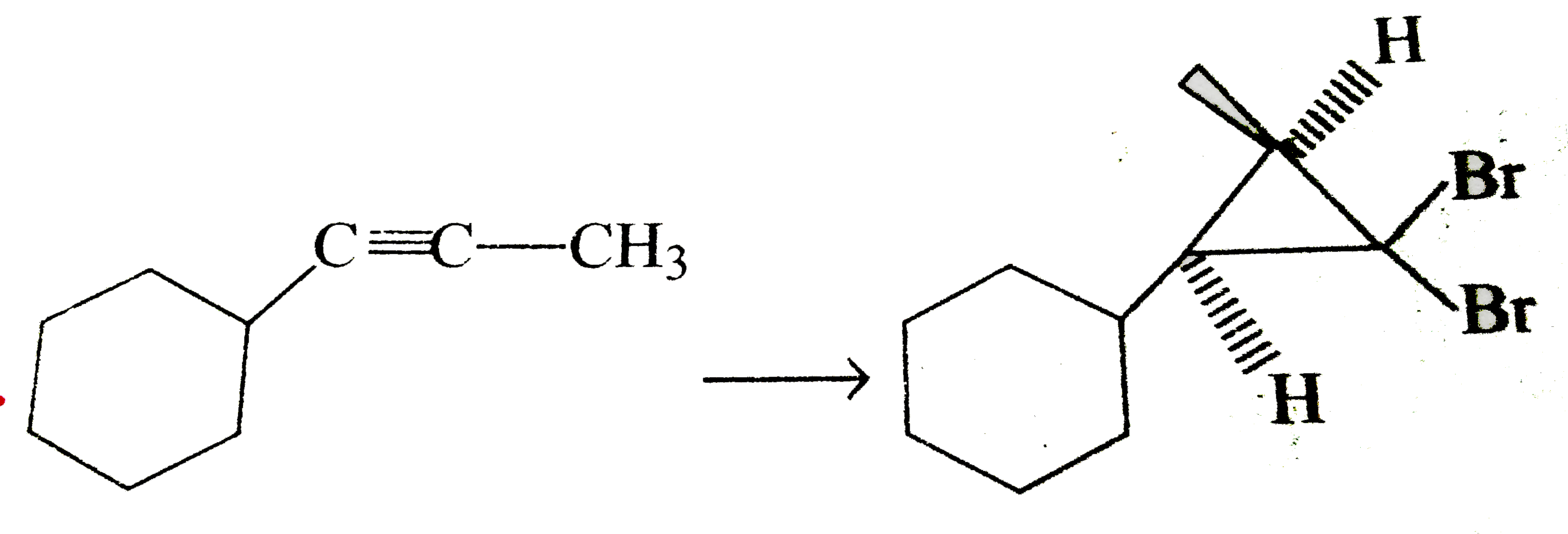
To carry out above conversion which reagent will be used?
View SolutionWhat is the IUPAC name for the following compound?
`CH_(3)-C-=C-overset(CH_(3))overset(|)(C)H-CH=CH_(2)`
View SolutionWhat is the major poduct expected from the following reaction?
View SolutionWhat is the major product expected from the following reaction?
`CH_(3)-C-=C-CH_(3)underset("low pressure poisoned catalyst")overset(D_(2)" one mole")to`
View SolutionWhat is the major product expected from the following reaction
`CH_(3)-C-=C-Hunderset(NH_(3))overset(NaNH_(2))to`
View SolutionWhat is the major product expected from the following reaction?
`H-C-=C-CH_(2)-CH=CH_(2)underset(HgSO_(4))overset(H_(2)O,H_(2)SO_(4))to`
View SolutionVinyl acetelyne `overset(x)to` chloroprene: x is
View SolutionWhich of the following reactions will produce the 2-pentyne in good yield?
`CH_(3)-CH_(2)-C-=C-CH_(3)`
View SolutionWhich of the following compounds will produce butanone when treated with `H_(2)SO_(4) , HgSO_(4)` and water?
View SolutionWhich of the following is redox reaction?
View SolutionNumber of collinear carbons in 2,4-hexa diyne
View SolutionIUPAC name of the product obtained on reductive ozonolysis of acetylene
View SolutionWhich of the following can give nucleophilic addition on alkyne
View SolutionThe compounds 1-butyne and 2-butyne can be distinguished by using
View SolutionWhich of the following is havin highest heat of hydrogenation?
View Solution
A is.
View SolutionWhich of the following alkyne on treatment with `H_(2)("2 mole")`/Pt gives an optically inactive compound?
View SolutionArrange the following carbanions in order of their decreasing stability.
(I). `H_(3)C-C-=C^(-)`
(II). `H-C-=C^(-)`
(III). `H_(3)C-CH_(2)^(-)`
View Solution`CH-=CH underset(dil.H_(2)SO_(4))overset(Hg^(2+))toAunderset(HCl)overset(Zn-Hg)toB` B is
View Solution`HO-CH_(2)-CH_(2)-C-=CH underset(CH_(3)-CH_(2)-X)overset(1eqoverset(odot)(NH_(2)))to`
View SolutionCyclic structure
`C_(6)H_(5)-CH=CH_(2)overset(Br_(2))toAunderset(NaNH_(2))overset("Three equivalent")toBoverset(CH_(3)I)toC` compound C in the sequence is
View SolutionWhich alkyne will give 3-ethylhexane on catalytic hydrogenation?
View SolutionWhich of the following statements best explain the greater acidity of terminal alkynes `(RC-=CH)` compared with monosubstituted alkenes `(RCH=CH_(2))`?
View Solution O is
O is
View Solution`Xunderset((2)H_(2)O //H^(+))overset((1)O_(3))toCH_(3)-CH_(2)-COOH^(+)`
`HOOC-CH_(2)-CH_(2)-COOH+HCOOH`
View SolutionWhat is the final product, C of the following reaction sequence?
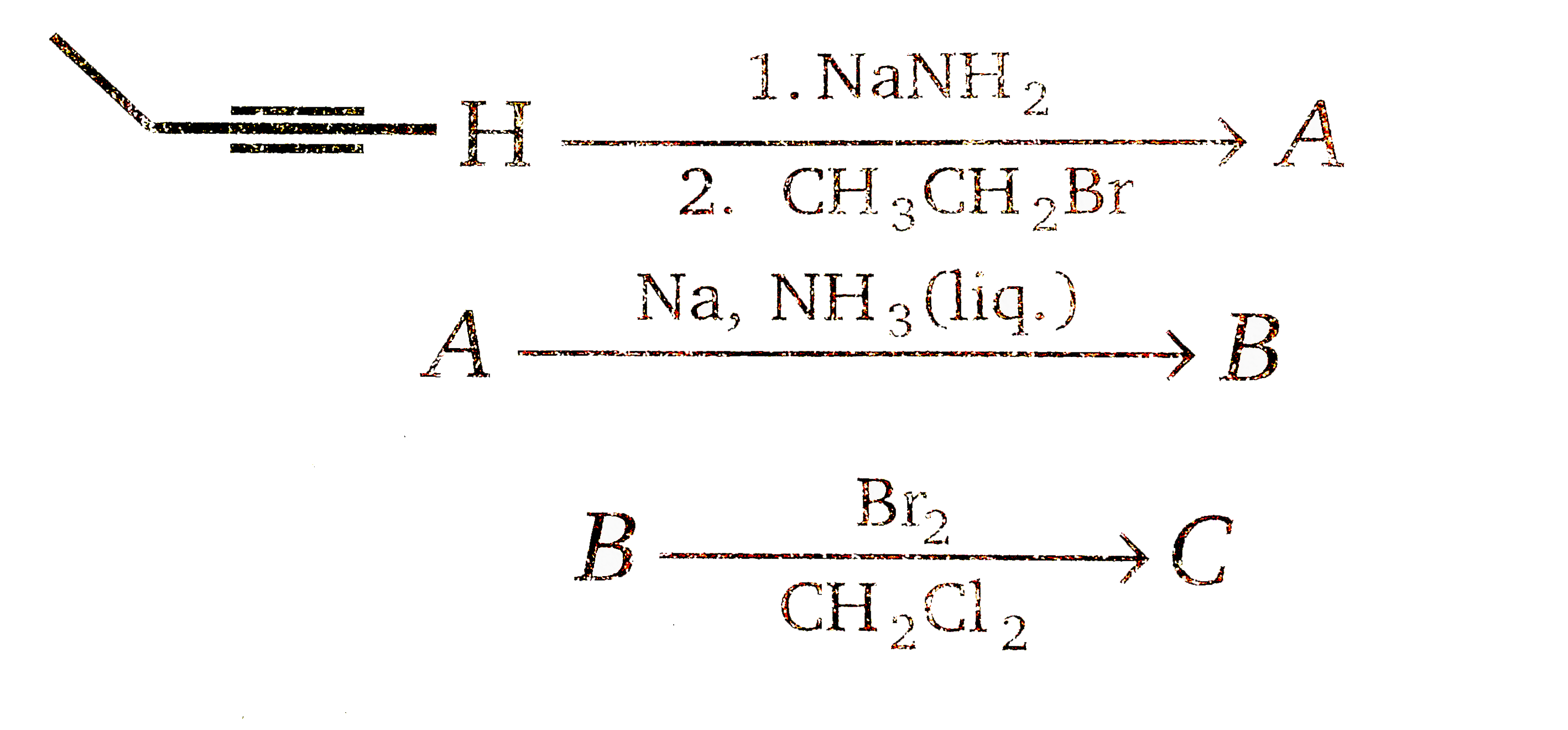
View SolutionWhich of the following compounds on hydrolysis gives acetylene ?
View Solution
`underset(heat)overset((CH_(3))_(3)COK^(+),DMSO)to` Identify the product.
View SolutionThe Products of the following I and II sequences are related as:

View Solution
Identify the product?
View Solution
(A) is
View SolutionThe set of reagents that needed to carry out the following conversion are
`CH_(3)-CH_(2)-C-=CHtoCH_(3)-CH_(2)-CH_(2)-CHO`
View Solution`2-`Hexyne gives trans `-2-` hexene on treatment with `:`
View SolutionArrange the following compounds in decreasing order of acidic charater
I. Butene
II. But1-1-ene
III. But-1-yne
IV. `Pt//H_(2)`
View Solution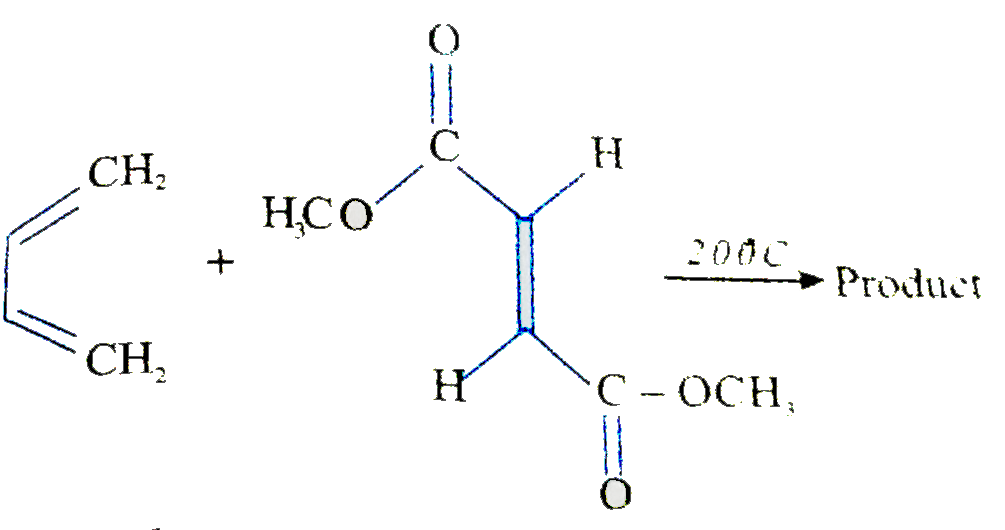
Here the product will be
View SolutionAddition of 1 equivalent of HCL to `CH_(2)=C=CH_(2)` gives
View SolutionWhich of the following reactions are ot feasible?
View Solution`Bu-C=CHoverset(NaNH_(2)rarrAoverset(Ph-CHO)underset(H_(2)O)rarroverset(MnO_(2))rarrC`
Compound C of the reaction cannot be:
View SolutionAcetone is the major product in:
I `H_(2)C=C=CH_(2)overset(H_(3)O)rarr`
II `H_(3)C-CH=overset(Hg^(+2)//H_(2)SO_(4))rarr`
III `H_(3)C-CH=overset(BH_(3).THF)underst(H_(2)O_(2)//OHrarr`
View SolutionPredict the products of following reactions:

View Solution`H_(3)C-C=Choverset(1.NaNH_(2))underset(2.CH_(3)CH_(2)Br)rarrAoverset(H_(2))underset(Pd-BaSO_(4)B:`
View Solution`H_(3)C-C-=Choverset(NaNH_(2))toXunderset(H_(2)O)overset("Acetone")toYunderset(Delta)overset(Conc.H_(2)SO_(4))toZ`:
View Solution
View SolutionWhich of the following solubility orders in water are correct ?
View SolutionThe reagents used to convert (E)-2,3-dibromo-2-butene to 2-butyne

View Solution
some statement regarding the reaction:
are given below. Select the correct statement(s).
View SolutionConjugated diene reacts with unsaturated hydrocarbon in presence of heat to lkproduce six membered cyclic product this reaction is known as Diels Alder reaction For this reaction conjugated diene should be in cisiod form. Aromatic hydrocarbon do not give Diels Alder reaction:

Which of the following conjugated unsaturated hydrocarbons will give Diels-Alder reaction?
View SolutionConjugated diene reacts with unsaturated hydrocarbon in presence of heat to lkproduce six membered cyclic product this reaction is known as Diels Alder reaction For this reaction conjugated diene should be in cisiod form. Aromatic hydrocarbon do not give Diels Alder reaction:

Which of the folowing Diels-Alder reactions is fastest?
View SolutionConjugated diene reacts with unsaturated hydrocarbon in presence of heat to lkproduce six membered cyclic product this reaction is known as Diels Alder reaction For this reaction conjugated diene should be in cisiod form. Aromatic hydrocarbon do not give Diels Alder reaction:

Find the product of folowing reaction:
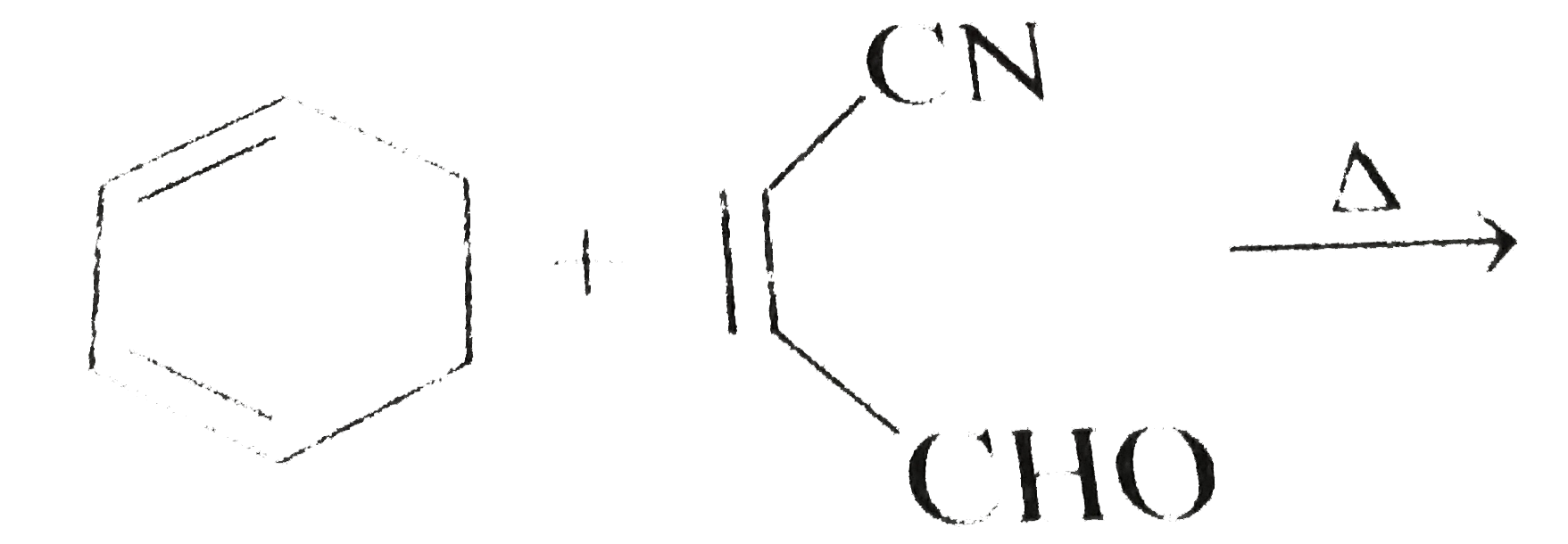
View SolutionAlkene and alkyne both undergo electrophilic additon beacuise of `pi` electron density, they behave as elctron rich species, alknens are more reactive toward this reaction because the intermiediate formed when an`E^(oplus)` adds to an alkyne is a vinylic cation wheras sthe intermediate formed when an `E^(oplus)` adds to akene is alkyl cation, which is mopre stable.
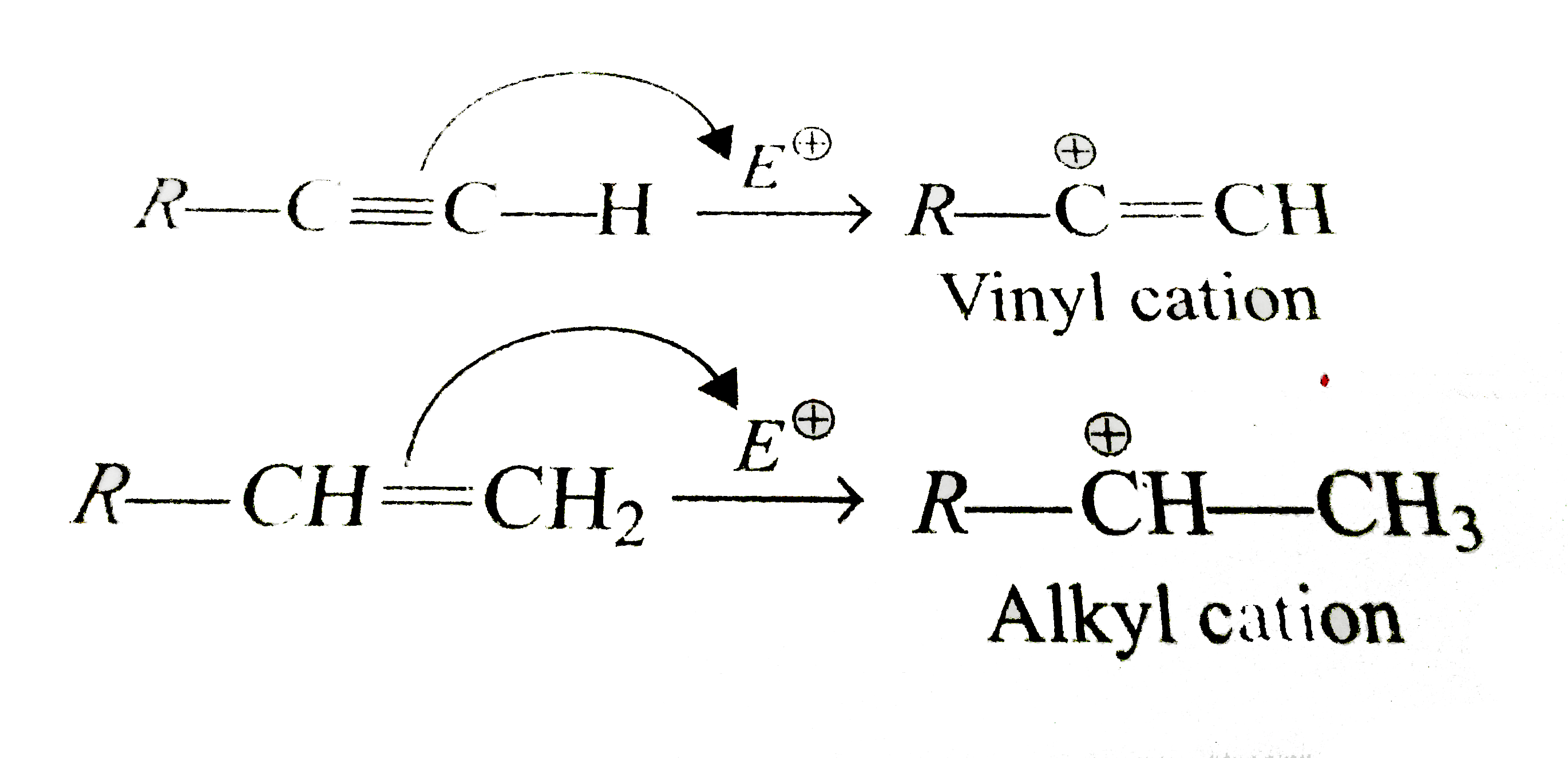
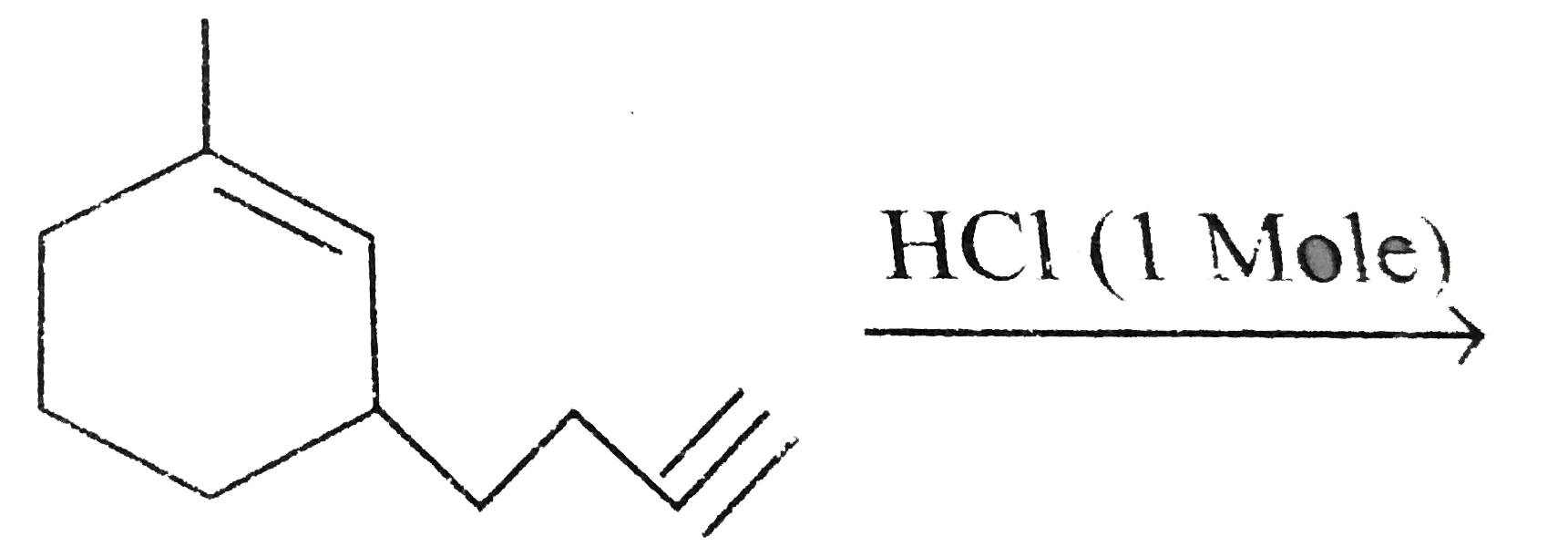
View SolutionAlkene and alkyne both undergo electrophilic additon beacuise of `pi` electron density, they behave as elctron rich species, alknens are more reactive toward this reaction because the intermiediate formed when an`E^(oplus)` adds to an alkyne is a vinylic cation wheras sthe intermediate formed when an `E^(oplus)` adds to akene is alkyl cation, which is mopre stable.
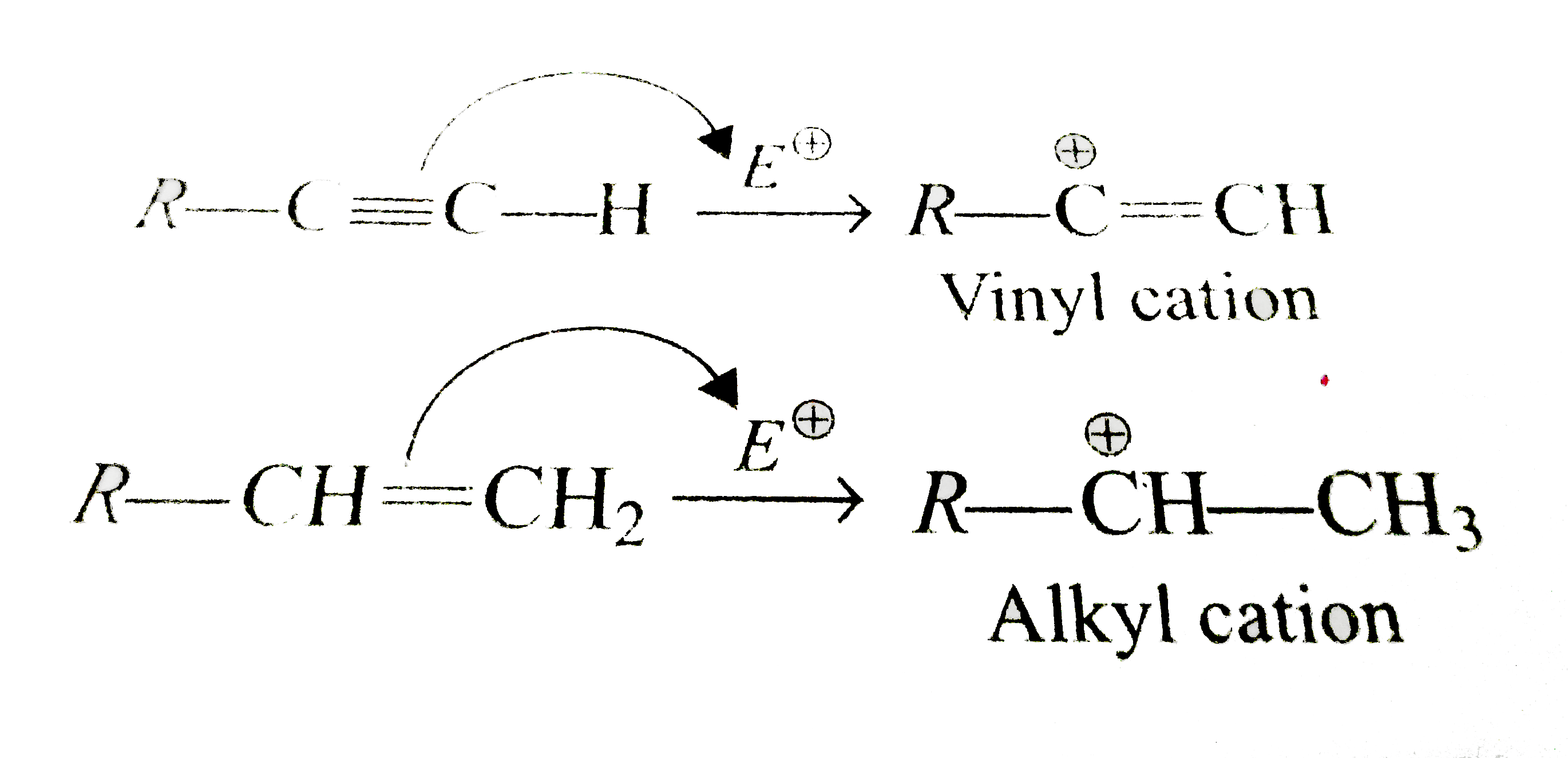

View SolutionAlkene and alkyne both undergo electrophilic additon beacuise of `pi` electron density, they behave as elctron rich species, alknens are more reactive toward this reaction because the intermiediate formed when an`E^(oplus)` adds to an alkyne is a vinylic cation wheras sthe intermediate formed when an `E^(oplus)` adds to akene is alkyl cation, which is mopre stable.
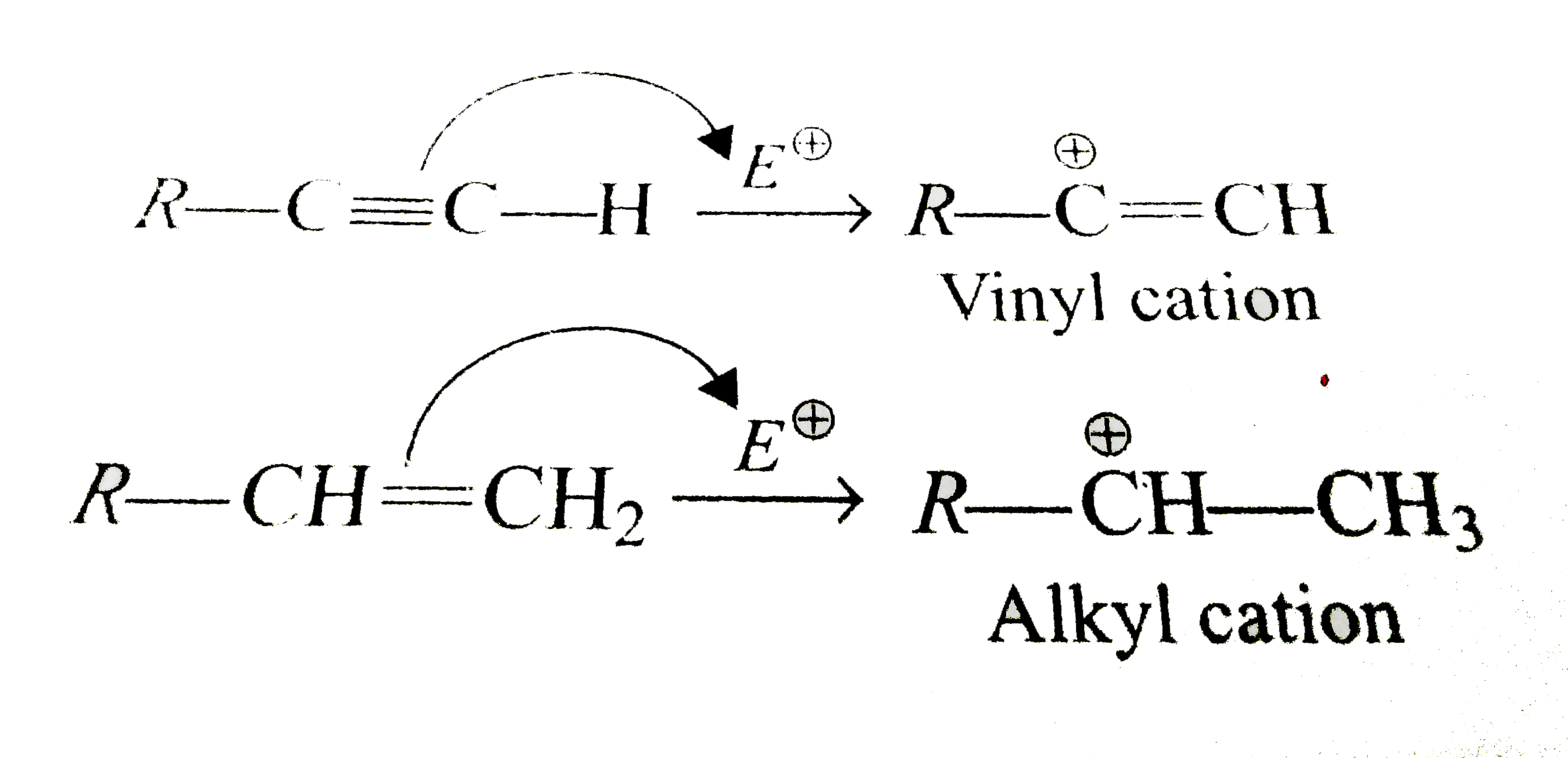 In the reaction:
In the reaction:

View Solution
Find structure of compound A:
View Solution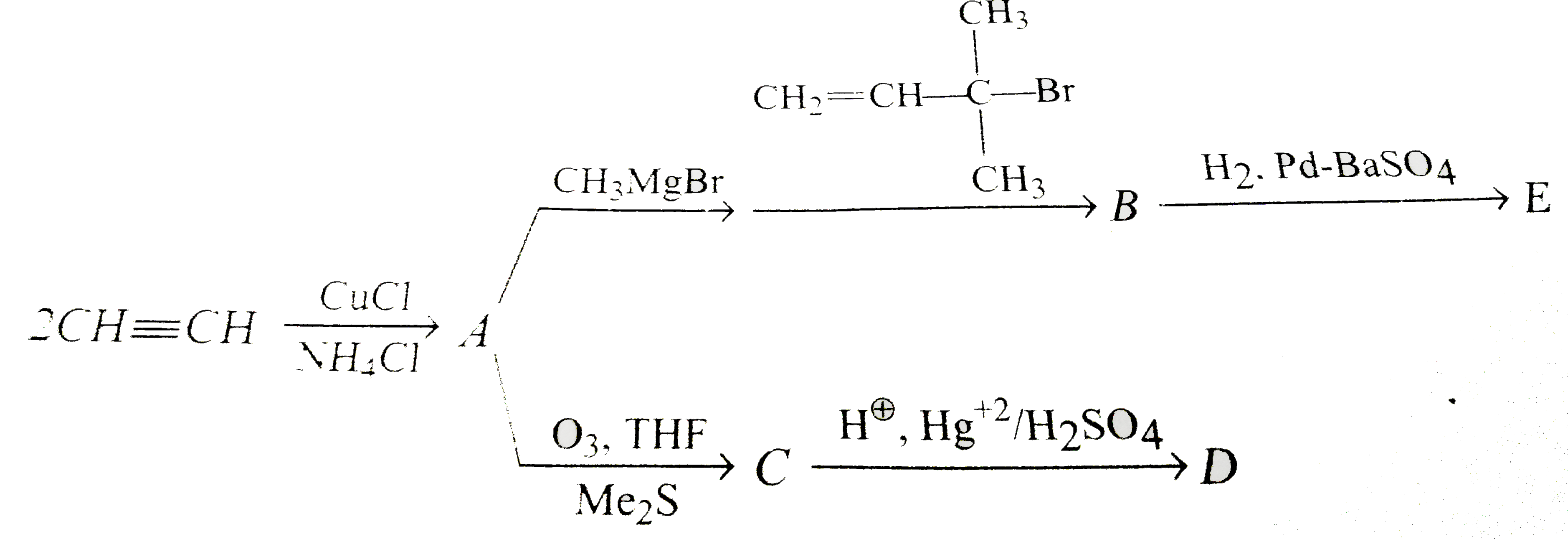
Find structure of compound E:
View Solution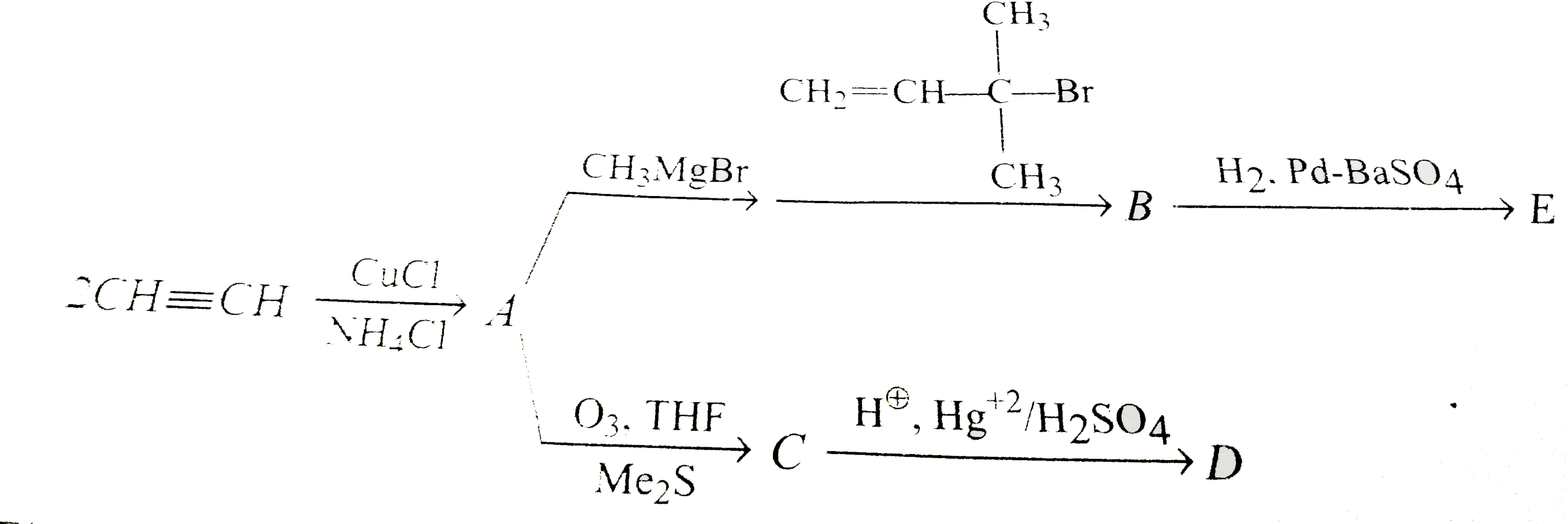
Find structure of compound D:
View Solution`CH_(3)-C-=C-CH_(3)overset("Cold " KMnO_(4))(to)(A)`
Product (A) is :
View SolutionDil, cold, alkaline `KMnO_(4)` is baeyers reagent. It acts as oxidizing agent
Q. `HC=CH"Baeyer's reagent"gtB("major")` B is
View SolutionDil, cold, alkaline `KMnO_(4)` is baeyers reagent. It acts as oxidizing agent
Q. `R-CH_(2)-C-=C-CH_(2)-Runderset(Delta)overset(KMnO_(4),OH^(-))toC` is
View Solution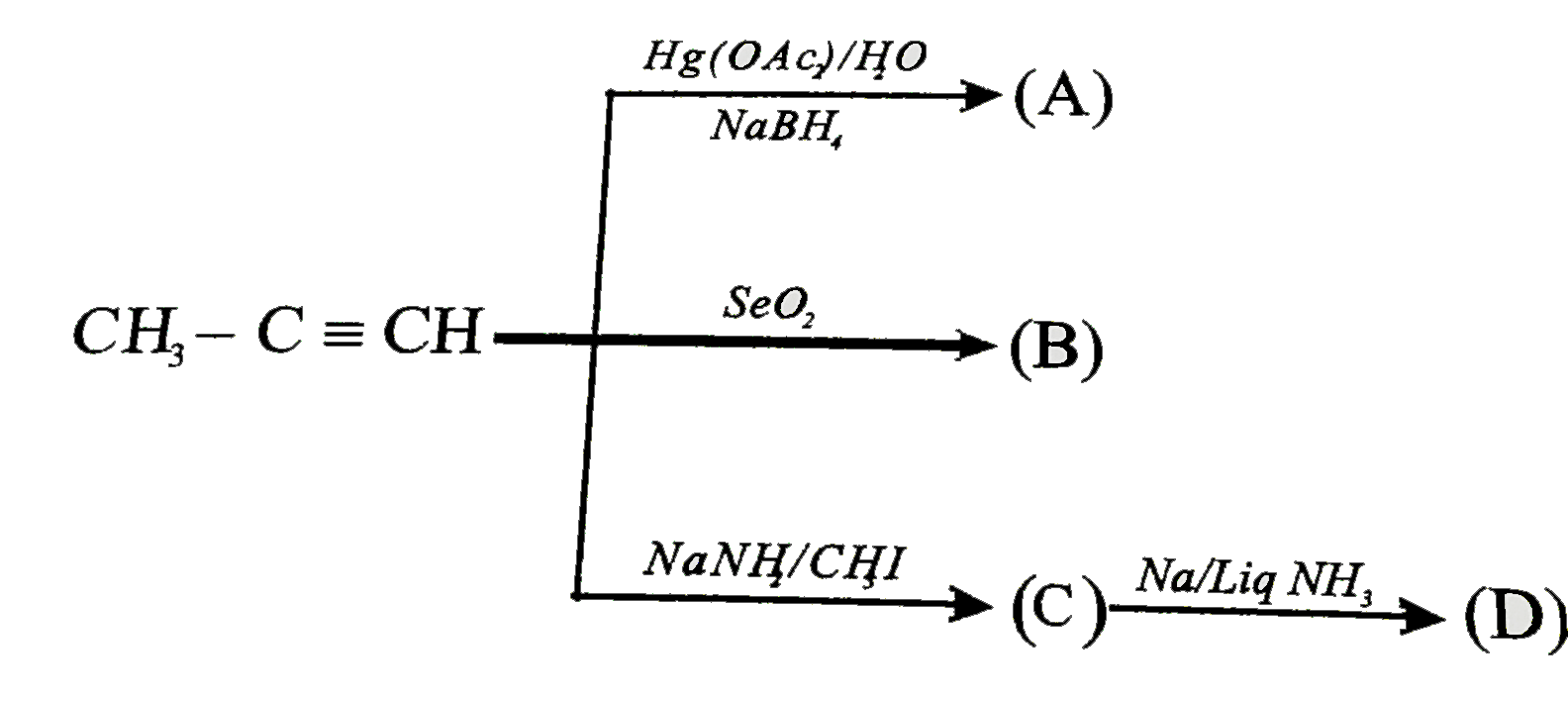
Q. Structure of A is
View Solution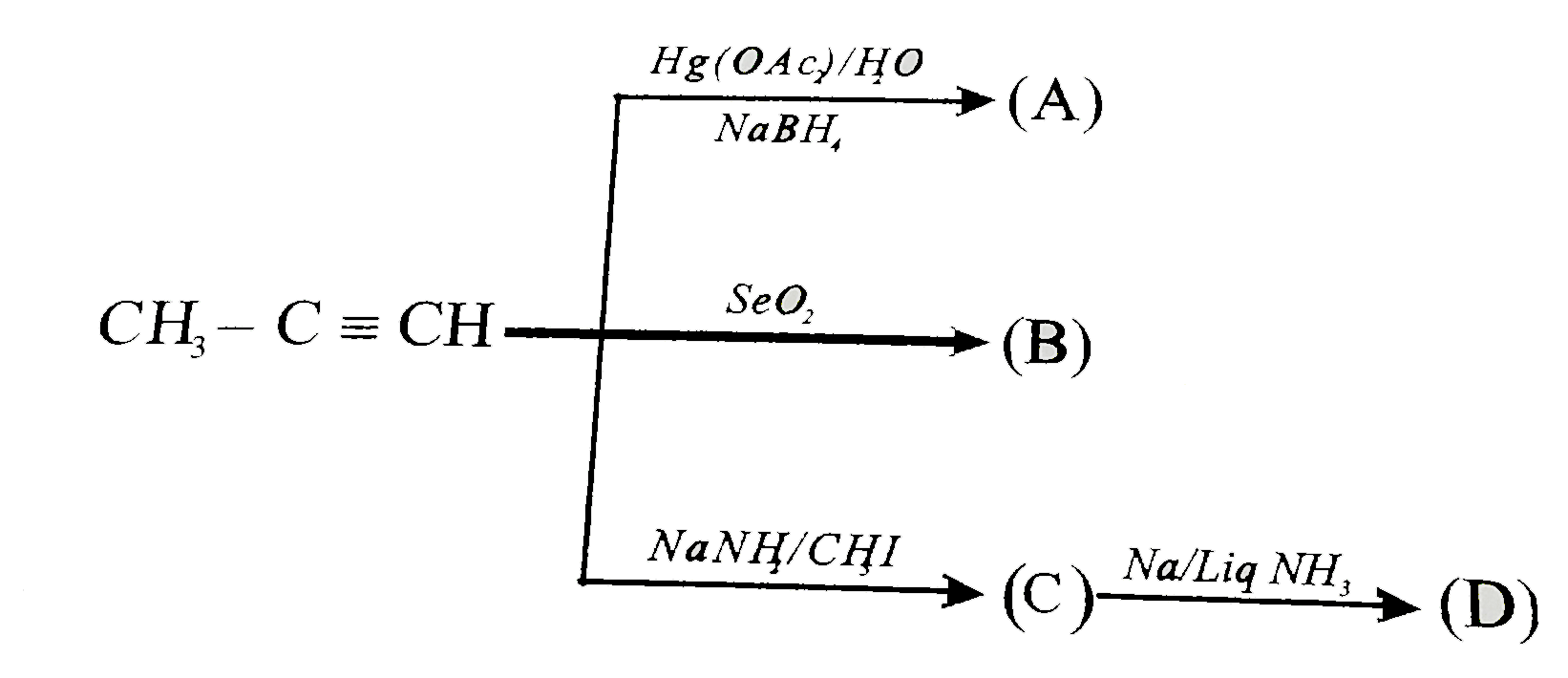
Q. Structure of B is
View Solution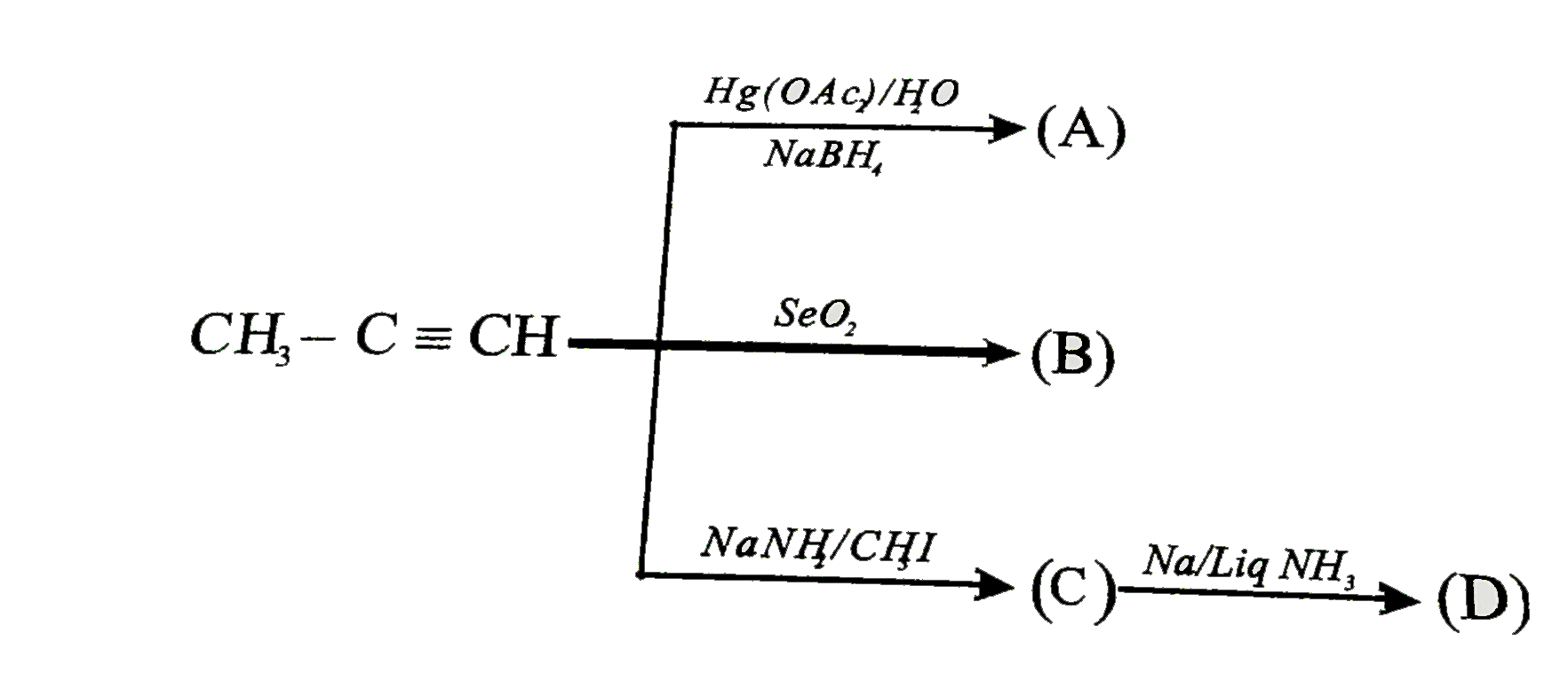
Q. Structure of D
View SolutionTerminal alkyne is very weak acid, it forms salt with very strong base such as `NaNH_(2)` and sodium metal.
`R-C-=C-Hunderset(NH_(3)(l))overset(NaNH_(2))toR-C-=overset(ө)(C)overset(o+)(N)a+(1)/(2)H_(2)`
Sodium salt of alkyne is known as shown alkynide. sodium alkynide is hydrolysed with water because it is salt.


Sodium salt behaves as nucleophile as well as strong base. for P-alkyl halides it behaves as a cucleophile. thus primary alkylhalides gives SN reaction halids it behaves as strong base hence they undergo elimination reaction.
Q. `R-CH_(2)-C=ClIunderset(NH_(3)(l))overset(Na)toPoverset(CH_(3)-CH_(2)Br)toR`. R is
View SolutionTerminal alkyne is very weak acid, it forms salt with very strong base such as `NaNH_(2)` and sodium metal.
`R-C-=C-Hunderset(NH_(3)(l))overset(NaNH_(2))toR-C-=overset(ө)(C)overset(o+)(N)a+(1)/(2)H_(2)`
Sodium salt of alkyne is known as shown alkynide. sodium alkynide is hydrolysed with water because it is salt.


Sodium salt behaves as nucleophile as well as strong base. for P-alkyl halides it behaves as a cucleophile. thus primary alkylhalides gives SN reaction halids it behaves as strong base hence they undergo elimination reaction.
Q. `CH_(3)-overset(Br)overset(|)(C)H-CH_(3)overset(R-C-=overline(C)overset(+)(N)a)toS+T+Br^(-)` S and T are
View SolutionTerminal alkyne is very weak acid, it forms salt with very strong base such as `NaNH_(2)` and sodium metal.
`R-C-=C-Hunderset(NH_(3)(l))overset(NaNH_(2))toR-C-=overset(ө)(C)overset(o+)(N)a+(1)/(2)H_(2)`
Sodium salt of alkyne is known as shown alkynide. sodium alkynide is hydrolysed with water because it is salt.


Sodium salt behaves as nucleophile as well as strong base. for P-alkyl halides it behaves as a cucleophile. thus primary alkylhalides gives SN reaction halids it behaves as strong base hence they undergo elimination reaction.
Q. `CH_(3)-overset(Br)overset(|)(C)H-underset(Br)underset(|)(C)H_(2)underset((ii)NaNH_(3)Delta)overset((i)C_(2)H_(3)ONa,Delta)toVunderset((ii)H_(2)O)overset((i).CO_(2))toW` is
View SolutionA hydrocarbon (A) having molecular formula `C_(7)H_(14)` is capable to exhibit both geometrical and optical isomerism on oxidation with hot conc. `MnO_(4)` followed by heating with sodalime yields two alkanes (B) and (C). Mixture of B and C can also be formed by oxidatio with hot concentration alkaline `MnO_(4)^(-)` of hydrocarbon (D) having molecular formula `C_(7)H_(12)`, followed by heating with sodalime.
Q. The hydrocarbon (A) is
View SolutionA hydrocarbon (A) having molecular formula `C_(7)H_(14)` is capable to exhibit both geometrical and optical isomerism on oxidation with hot conc. `MnO_(4)` followed by heating with sodalime yields two alkanes (B) and (C). Mixture of B and C can also be formed by oxidatio with hot concentration alkaline `MnO_(4)^(-)` of hydrocarbon (D) having molecular formula `C_(7)H_(12)`, followed by heating with sodalime.
Q. Two compounds (B) and (C)
View SolutionA hydrocarbon (A) having molecular formula `C_(7)H_(14)` is capable to exhibit both geometrical and optical isomerism on oxidation with hot conc. `MnO_(4)` followed by heating with sodalime yields two alkanes (B) and (C). Mixture of B and C can also be formed by oxidatio with hot concentration alkaline `MnO_(4)^(-)` of hydrocarbon (D) having molecular formula `C_(7)H_(12)`, followed by heating with sodalime.
Q. The hydrocarbon (D) is
View Solution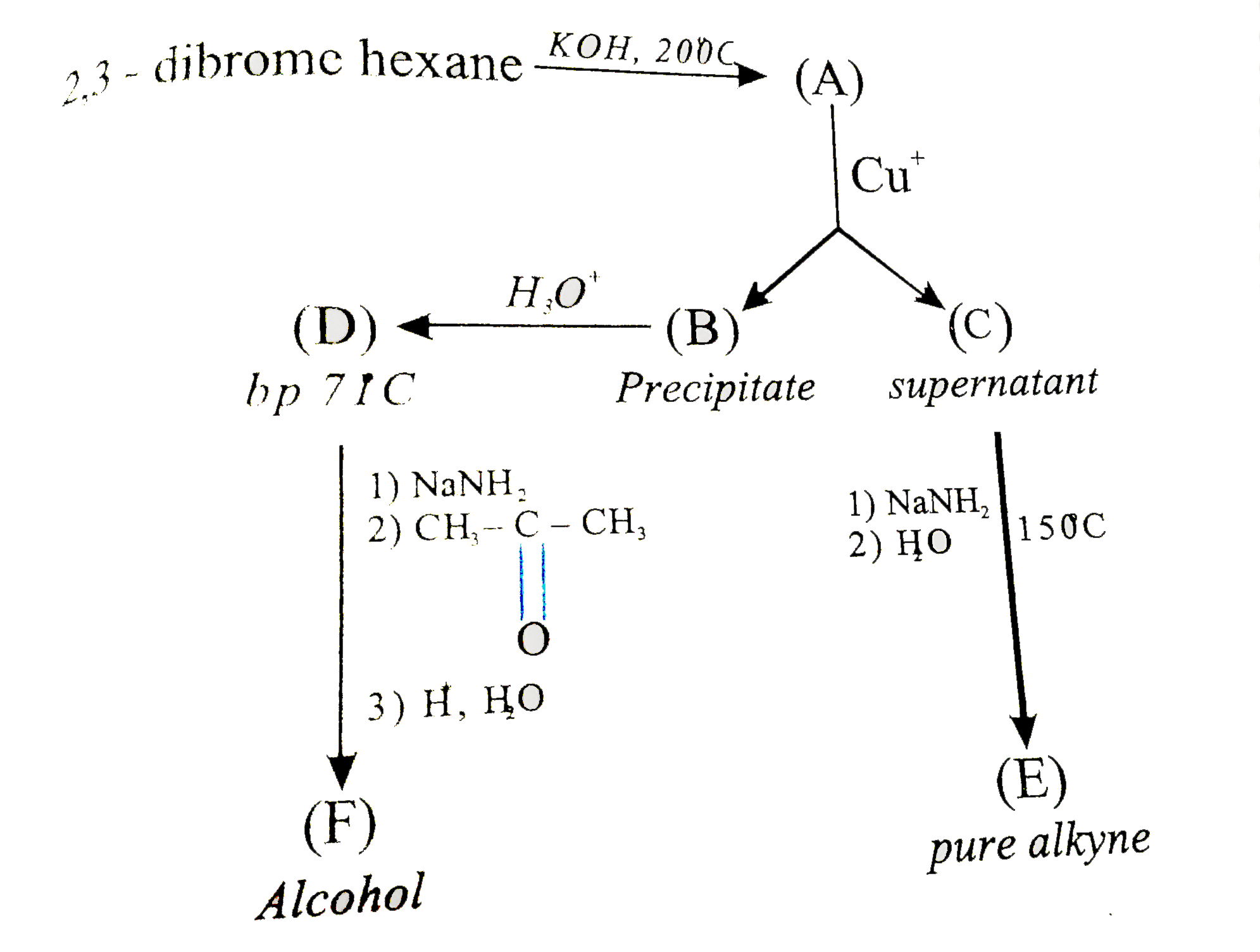
Q. 'B' in the above passage is
View Solution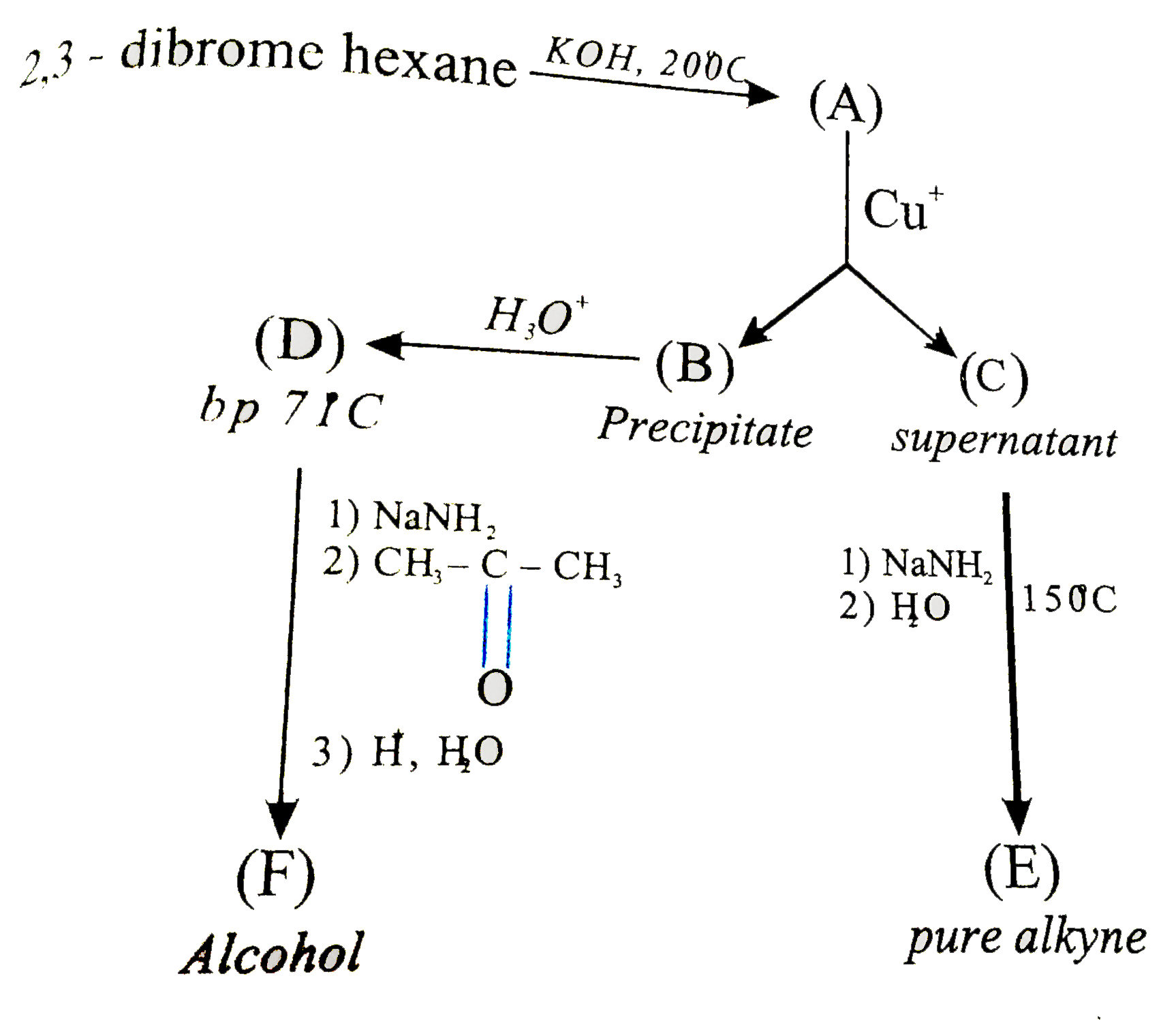
Q. The conversion of (D) to (F) involves
View Solution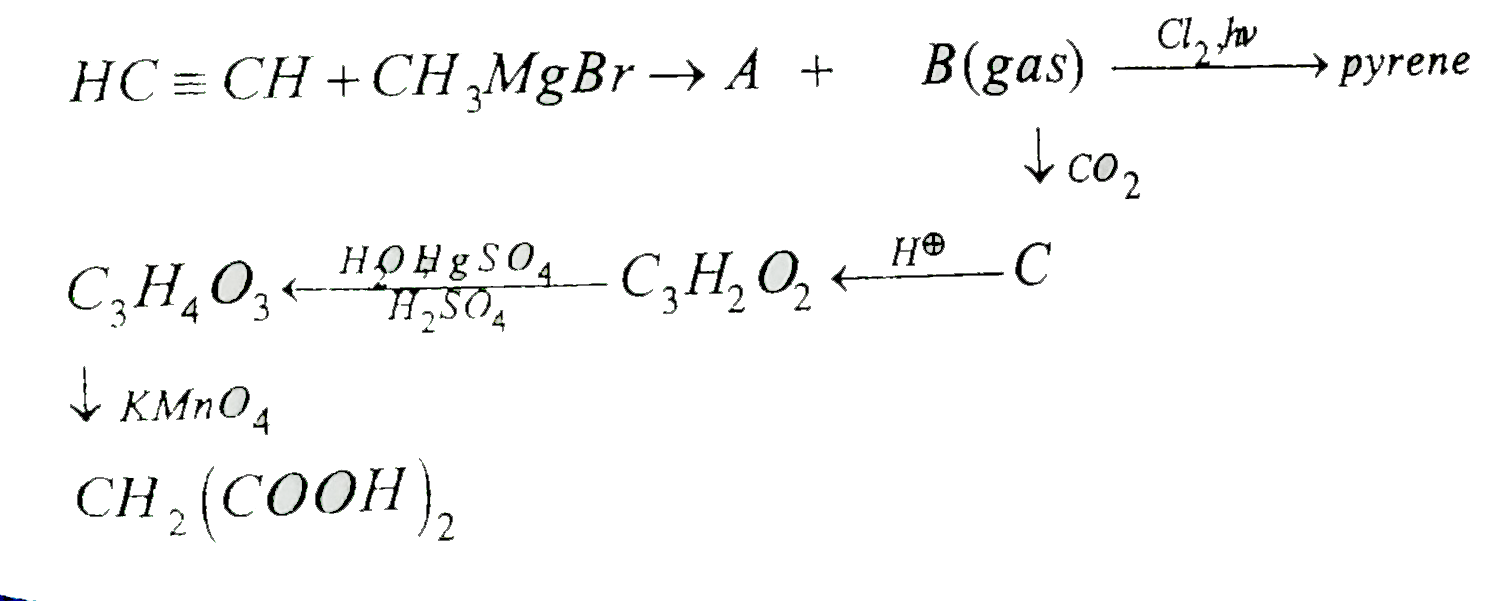
Q. The molecule `C_(3)H_(4)O_(3)` is sequential reaction is
View Solution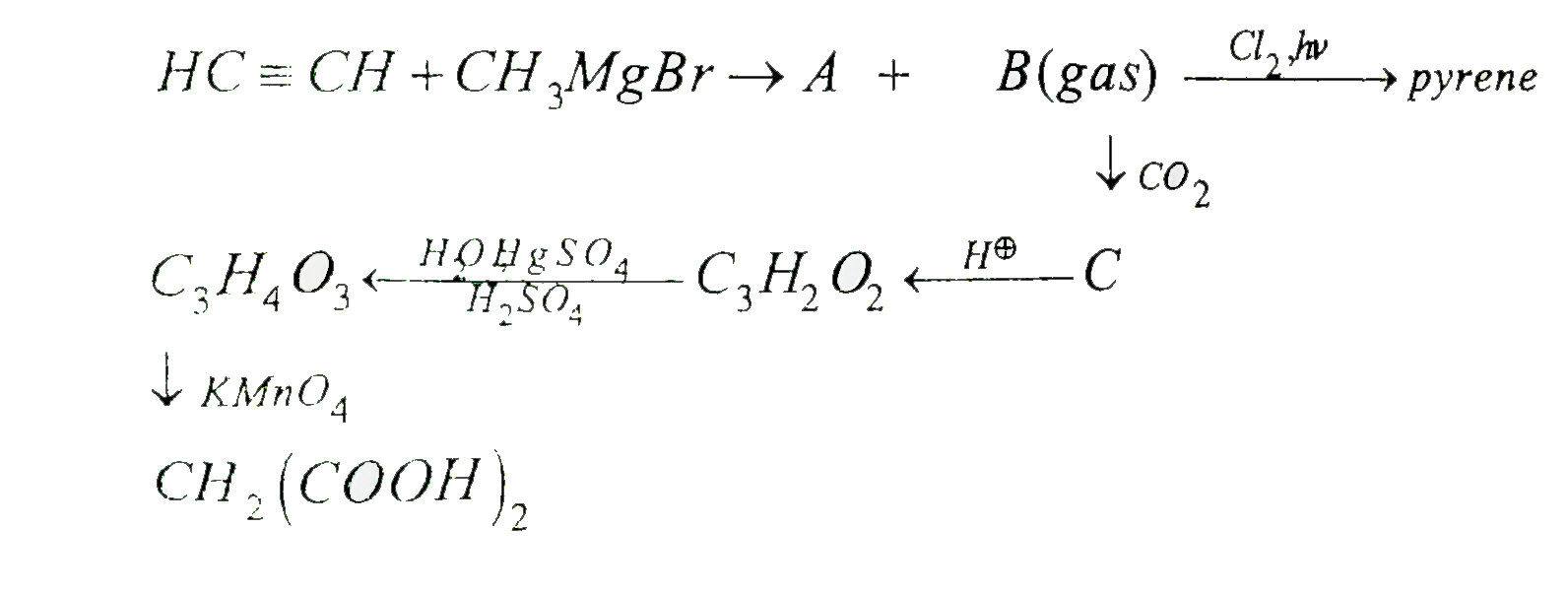
Q. `C_(3)H_(2)O_(2)underset(KMnO_(4))overset("Hot alkaline")to`Product. One of the products is
View Solution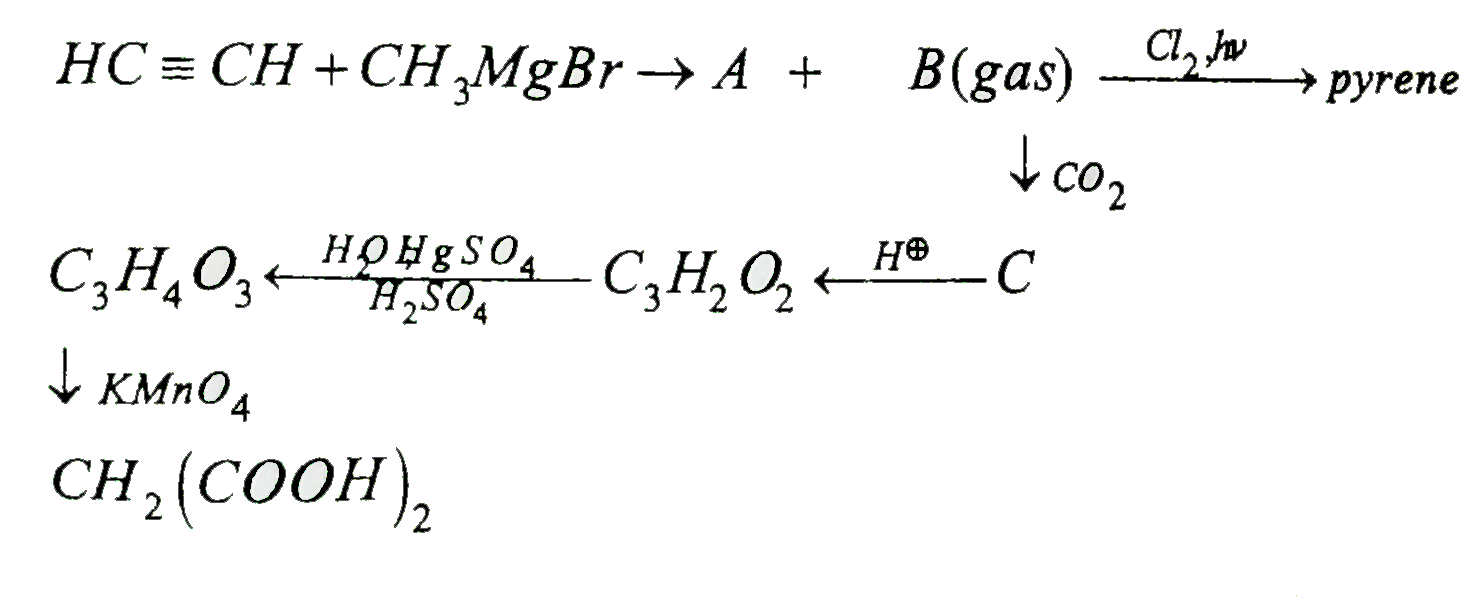
Q. In the sequential reaction, if instead of `CO_(2),(CH_(3))_(3)C-Br` is used. Product will be
View SolutionFrom the given sets, mathc appropriately
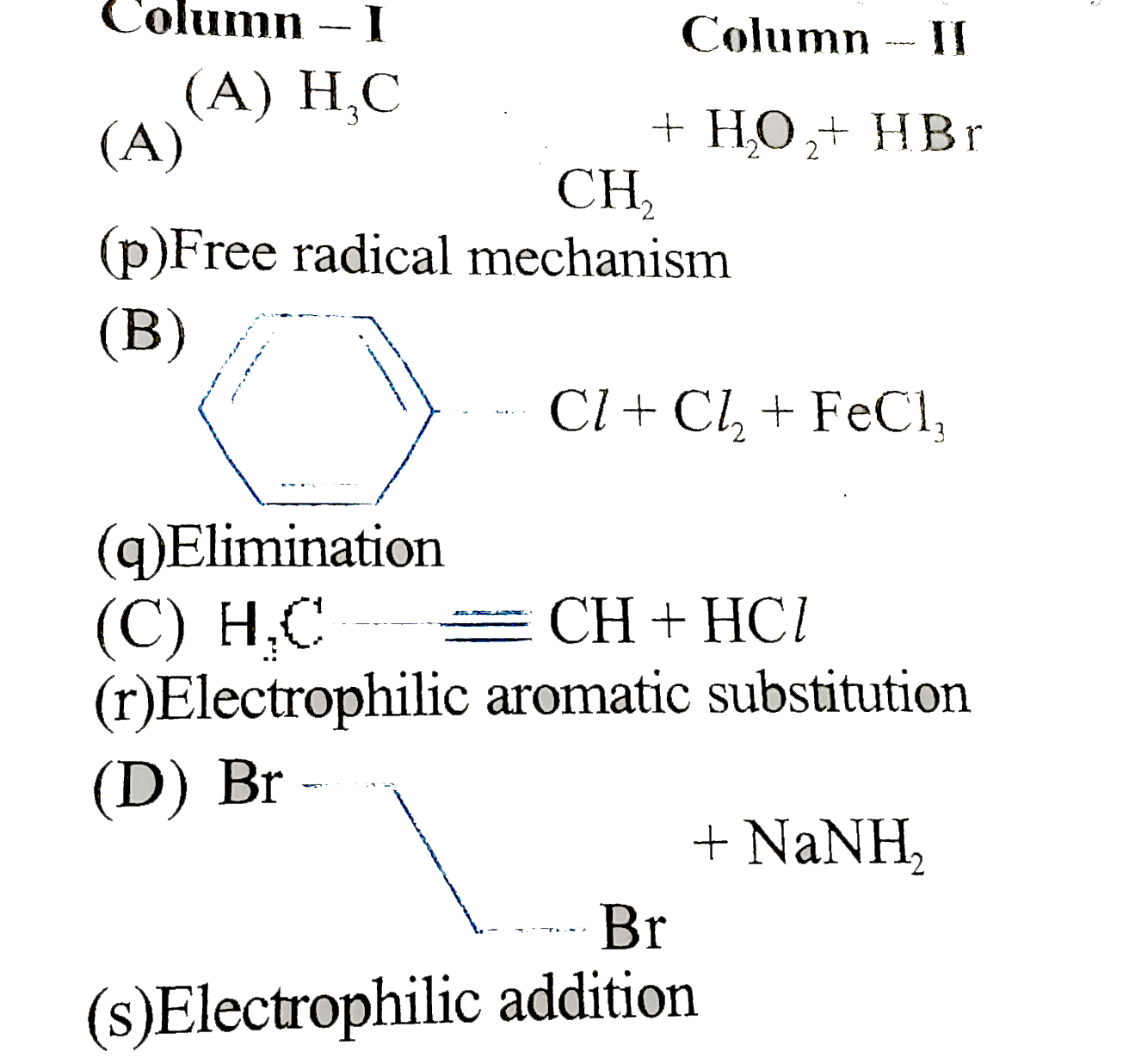
View SolutionMatch each of the following compound in column-I with the characteristic reaction in column-II
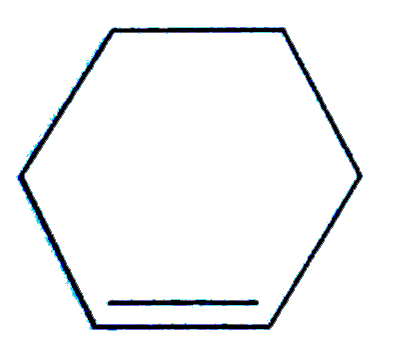
View SolutionMatch each of the compound in column I with the product of reductive ozonolysis in column-II
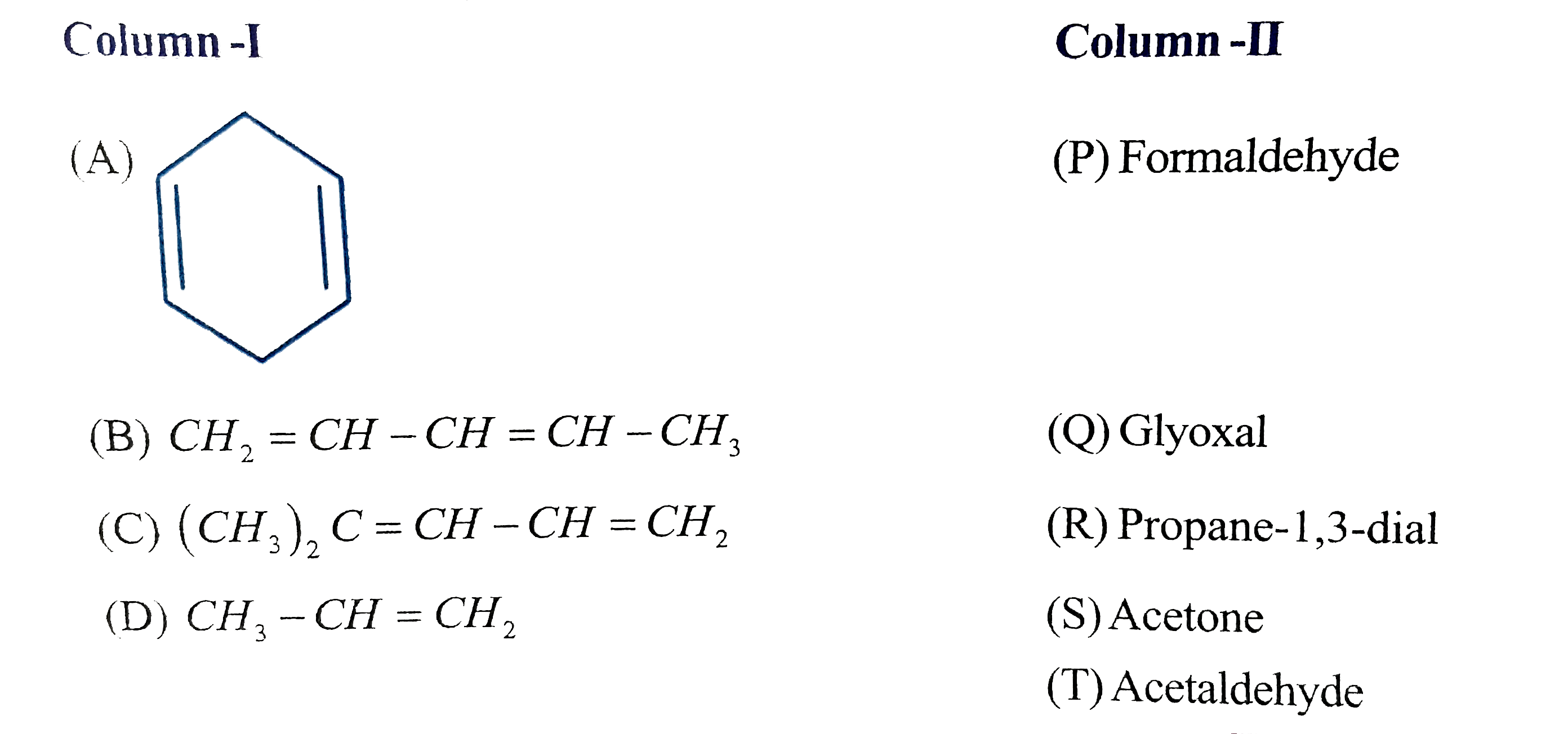
View SolutionMatch the following
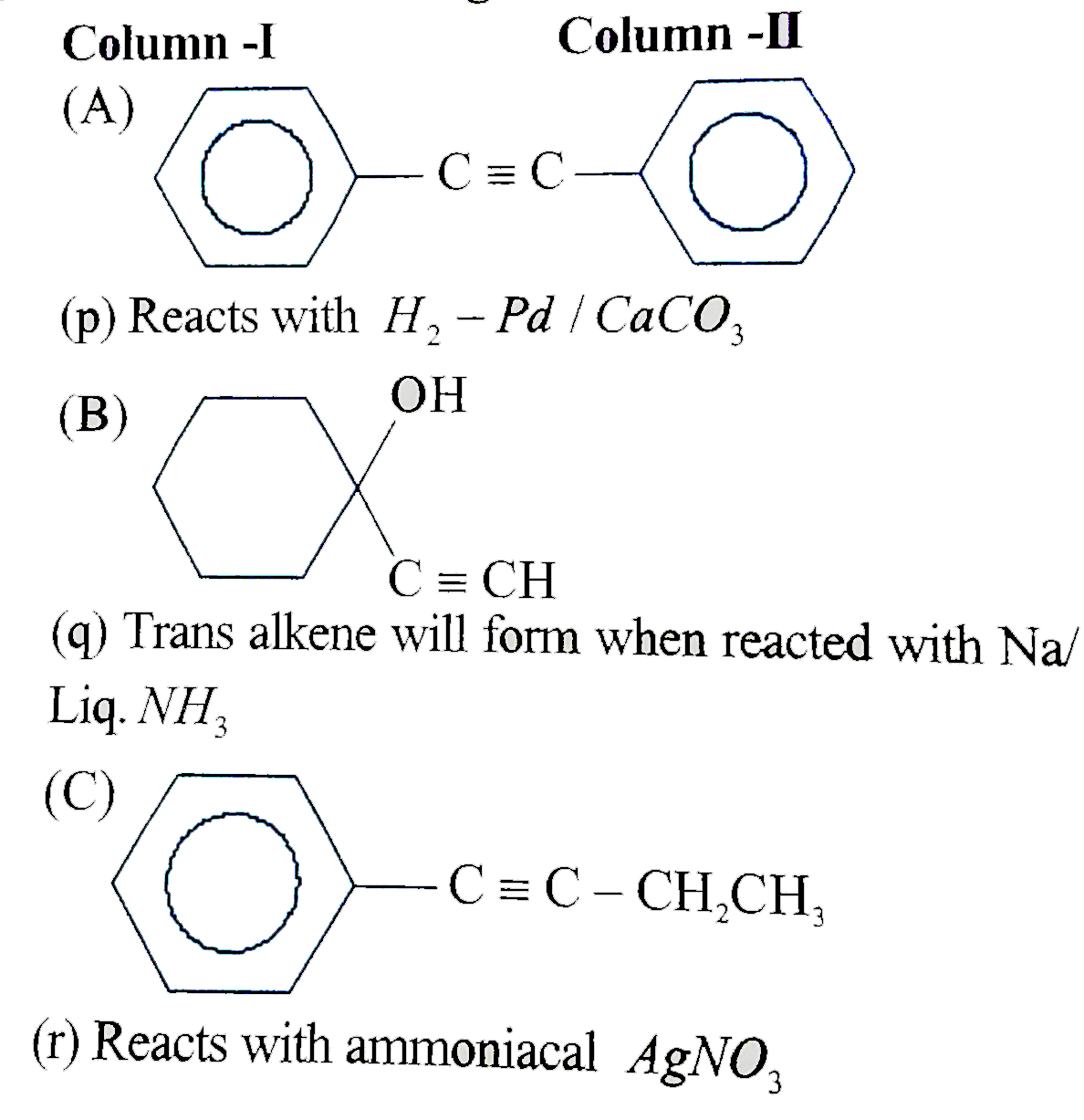
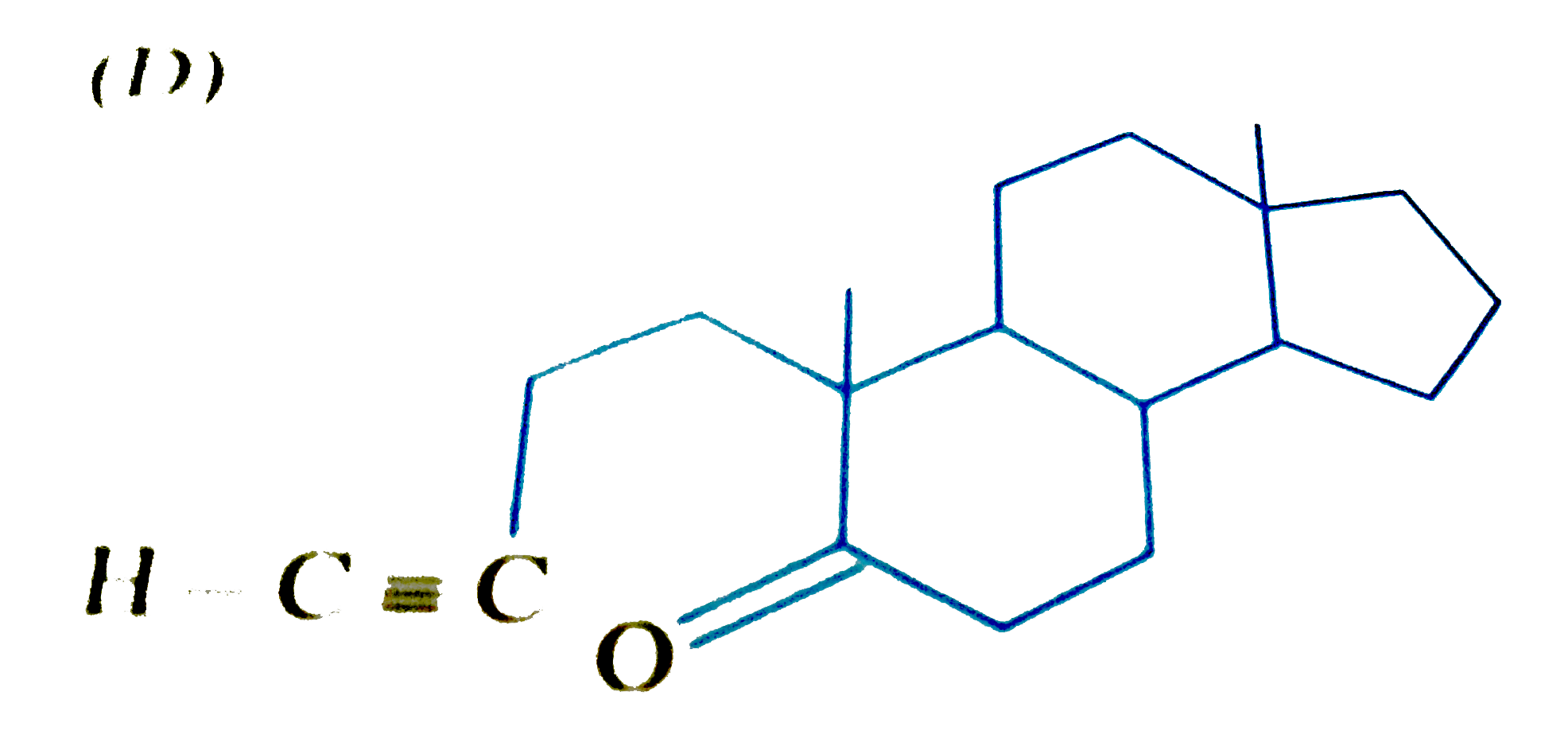
View SolutionMatch the following
Q.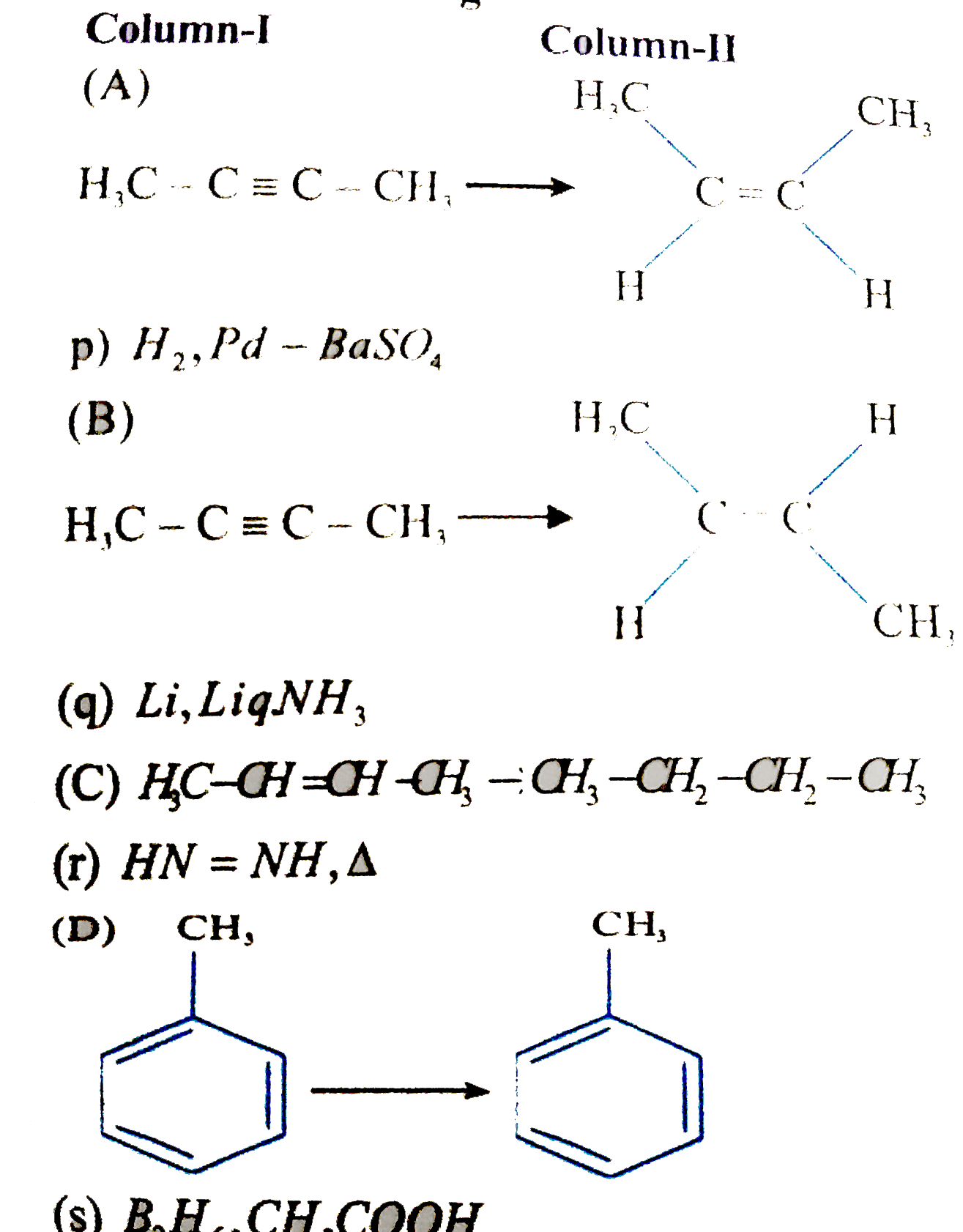
View SolutionMatc the following column-I with column-II
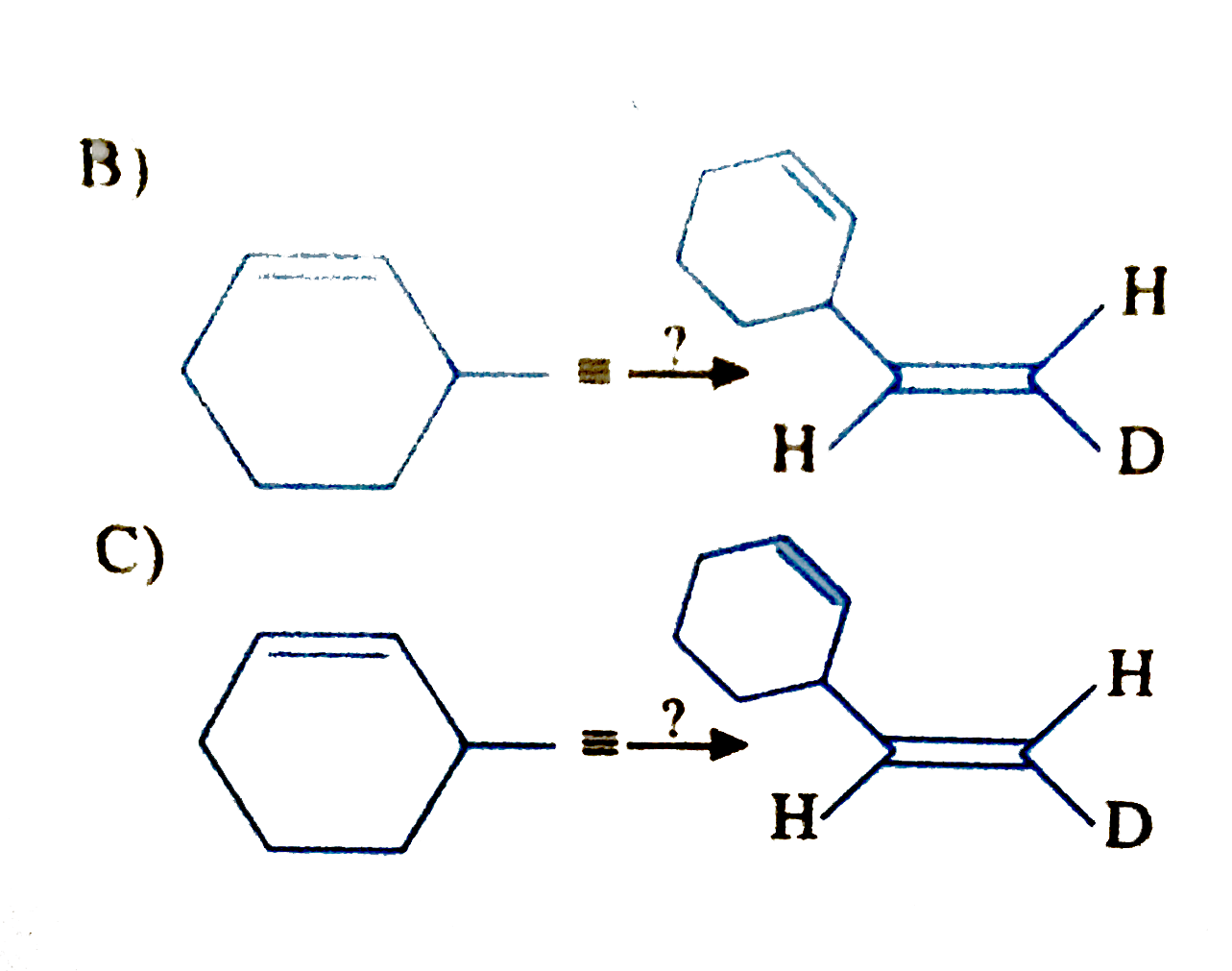
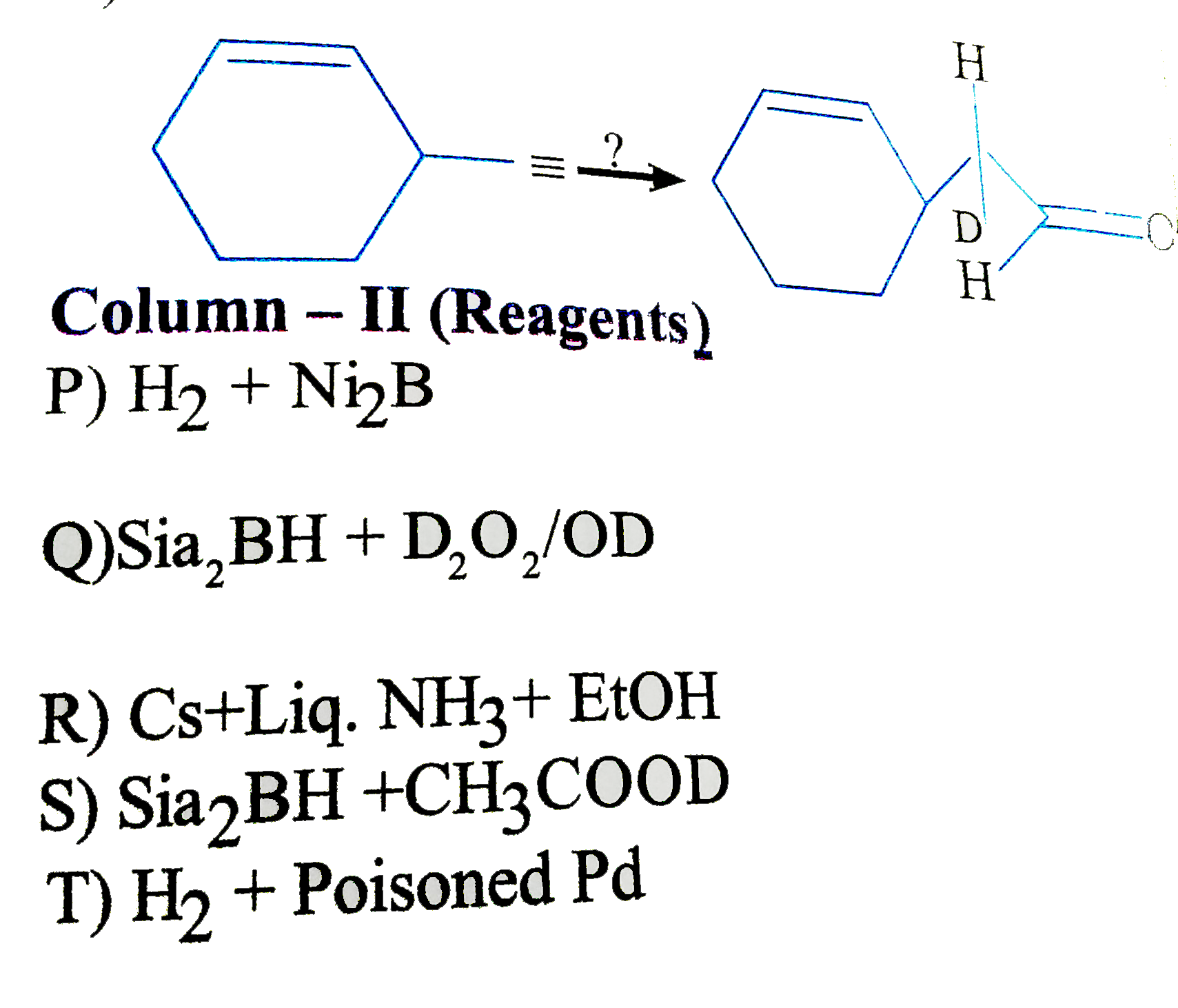 .
.
View SolutionMatch the following
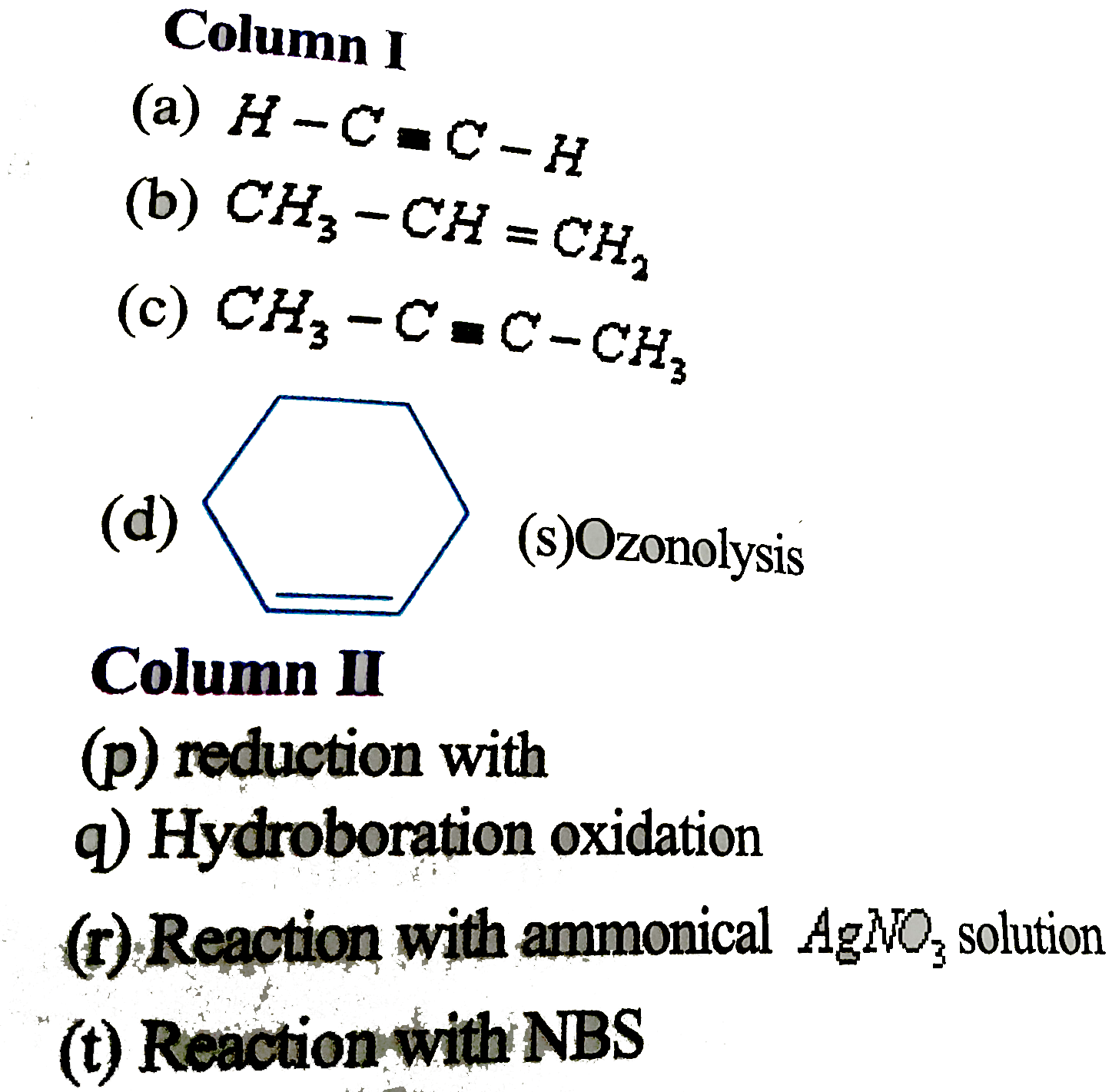
View Solution
Level-6 questions and complete solutions for chapter ALKYNES of NARAYANA CHEMISTRY (HINGLISH) of Class 11